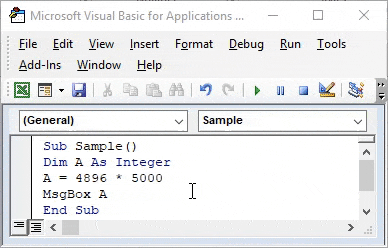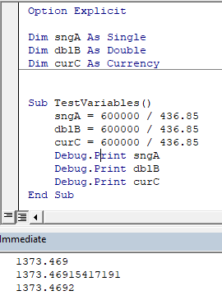

To work around this situation, type the number, like this: Dim x As Longįor additional information, select the item in question and press F1 (in Windows) or HELP (on the Macintosh). You attempt to use a number in a calculation, and that number is coerced into an integer, but the result is larger than an integer. Make sure your assignment fits the range for the property to which it is made. Functions are not allowed in constant expressions.

Const SecondsPerYear As Long 60 60 24 365 Compile Error: Overflow COMPILE ERROR: Constant Expression Required We can't use CLng () to define a constant because it's a function. to assign a value of more than 255 to a byte results in an overflow error. According to Microsoft's website, a VBA integer should be able to hold values between -2,147,483,648 and 2,147,483,647. Overflow because the literal numbers are all treated as Integer types. 'at the module level Public iState As Integer Sub PublicVariable() iState. The result of an assignment, calculation, or data type conversion is too large to be represented within the range of values allowed for that type of variable.Īssign the value to a variable of a type that can hold a larger range of values.Īn assignment to a property exceeds the maximum value the property can accept. Changing LastRow to Long returns the correct value of 70,000. This error has the following causes and solutions: I did not realize, that a situation could happen when there is no match at all and the rowSource will be counting to infinity :) Just had to take care of that and that's it.An overflow results when you try to make an assignment that exceeds the limitations of the target of the assignment. Code: Sub LongExample1 () Dim k As Long k Rows.Count End Sub Now, show the value in the message box.
#VBA INTEGER OVERFLOW CODE#
For getting the total count of rows in the excel worksheet, the code is Rows. If Cells(rowTarget, 1) = WS.Cells(rowSource, 1) ThenĬells(rowTarget, 10) = WS.Cells(rowSource, 10)ĮDIT:// Ok after I posted this thread I found the solution. Code: Sub LongExample1 () Dim k As Long End Sub Let us assign the value as a total row count of the worksheet.

According to Microsofts website, a VBA integer should be able to hold values between -2,147,483,648 and 2,147,483,647. Set WB = Workbooks("HPD_product_export_EN_NEW.xlsx") Changing LastRow to Long returns the correct value of 70,000. The Overflow error is on line rowSource = rowSource + 1 What I wan't to do is to compare first columns of both WBs with IDs and if they match then other columns should copy from Source to Target WB. According to Microsofts website, a VBA integer should be able to hold values between -2,147,483,648 and 2,147,483,647. All the following codes will result in an error: Dim intValue As Integer. The Source file has a significantly more items than the Target file. In VBA for word the conversion must be done explicitly. I have two workbooks - one source WB and one target WS. By far the most common cause of an overflow error in VBA is using an Integer variable type for a row number exceeding 32,767. I'm getting an Overflow error (Error 6) and I just don't understand why.


 0 kommentar(er)
0 kommentar(er)
